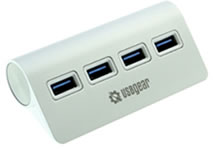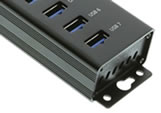A look at the applications for a powered USB hub
The powered USB hub varies from using bus power or a 12V power adapter to boost signal and function depending on the application it is intended for.
Why would you use a powered USB hub? What purpose does it serve? Technically all USB hubs are a powered hub but the application you are using it for determines the type of power that is supplied. Many USB 2.0 Hubs are bus powered by the Universal Serial Bus from within your system, these hub are generally installed into your system as a plug and play device. If you were to look at your device manager after connecting a USB hub, you would see that a "generic USB hub" is present and ready to use, this is the same for a USB 3.0 hub and Mini USB styled hubs.
A powered USB hub application can be industrial or commercial; there are factors to consider what makes a hub for industrial use or commercial use, some factors are listed below:
- Chassis material – metal or plastic
- USB specifications – USB hub 3.0 or 2.0
- What port hub – how many USB ports will be sufficient for your use.
- Environment considerations – how and where will the USB hub be stored, what environment will it be used in.
- Will the USB hub serve as networked device?
|
|
|
|
Example of what an industrial style powered USB hub might look like with a metal chassis and mounting flange. USB 3.0 4 Port Hub with LED status lights. |
Example of a commercial or home use USB 3.0 hub with an ergonomic face and stylish design, something that would be used on desktops. |
Isn’t all USB power the same?
Quick and simple answer is NO! Let's look at USB port power like this, any computer you have with a USB 2.0 port only puts out .5mA of power to your USB hub or other device. The hub in this case will be powered by .5mA and will only power USB devices connected to it that run off of .5mA, USB 2.0 hubs are not a high power hub, USB 2.0 hubs that require a power adapter are generally hubs that need to continue power consistently over a large number of USB ports for data and battery charging.
USB 3.0 hubs or USB 3.0 ports in general are slightly different in that the power needed is 900mA (.9mA) at the host port of your computer. USB 3.0 hub power needs are higher and can in some cases require a 12V power adapter to function properly.
Din rail for mounting
Moving away from powered USB hub we need to talk about mounting hubs. There are many USB hubs that mount in several ways, see below:
Methods of mounting a USB hub: Din Rail (by use of brackets or clips), rack mount, or flange mounting.
|
|
|
|
|
Din Rail Mount
|
Rack Mount
|
Flange Mount
|
- Din Rail mounting can be in the form of a flat bracket or a din rail clip, in both cases the bracket or clip is attached to the hub for mounting.
- Rack mount method requires a set of rack mount brackets to be attached via screws to either end of the hub and then attached to the rack for its intended purpose.
- Flange mounting is the method of mounting the hub by an attached flange or sometimes called an ear so that flat surface mounting can be implemented.
Mini USB – Keeping the hubs small but effective
Mini USB is still USB, just in a different package. These Mini USB devices are commonly used for travel with technicians or executives. The USB Mini style of hub generally relies on the bus power from the laptop computer but can also come equipped with an AC adapter for additional power in running peripherals. These hubs are ideal using small USB storage drives such as thumb drives to access information on the run. While on the move with mini USB, your most common devices can be used such as a USB Mouse, digital camera, USB printer and can be use with Windows and Mac machines with an available USB port.
This is the second in a series of USB hub articles and they have been pretty simple information to this point. Our goal is to provide information on a level that everyone can understand, not to confuse. In the forth coming articles, we will be getting a bit more technical as we talk about the true specifications of various hubs such as Data Hubs, USB Charging Hubs, and hubs that are a combination of both, all with spec differences that are significant to their function.
Read a companion article USB hub for valuable information, keeping you informaed.





